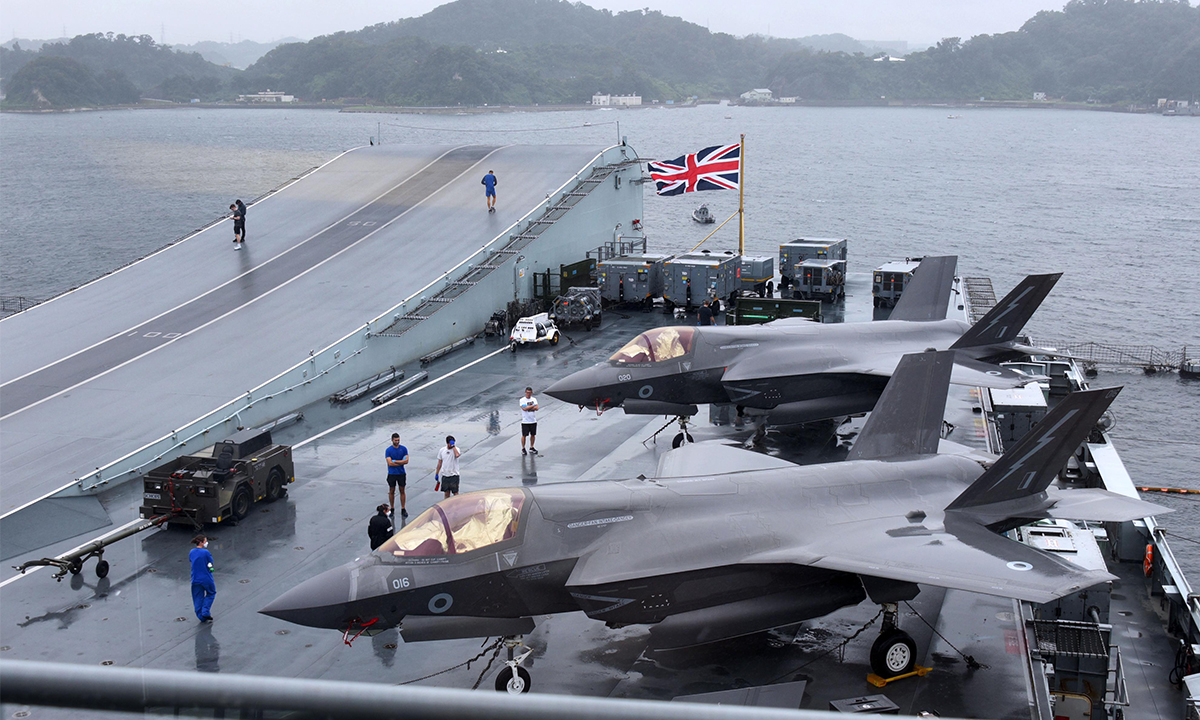
Photo taken on Monday shows F-35B fighter jets on the deck of British aircraft carrier the Queen Elizabeth at the US Navy base in Yokosuka, southwest of Tokyo. Photo: AFP
With two offshore patrol vessels setting out from a UK naval base on Tuesday, the country reportedly started to permanently station its warships in the Asia-Pacific region, at a time when the US is rallying its allies to the region in an attempt to confront and contain China.
Armed with only light weapons, the UK ships are only showing off their presence after Brexit and making political statements that the UK bows to the lead of the US. And just like the ongoing tour of the
HMS Queen Elizabeth aircraft carrier to the region, these vessels cannot yield any military significance or become a real threat to the Chinese People's Liberation Army (PLA), Chinese analysts said on Tuesday.
The
HMS Tamar and
HMS Spey on Tuesday left Portsmouth and set out for the Indo-Pacific region, the official Royal Navy Twitter account for HM Naval Base Portsmouth said on the day.
The two UK warships' permanent deployment in Asian waters is arranged with China "vying for influence with the US and Japan" and amid "growing alarm in recent months over China's territorial ambitions in the region, including Taiwan," Reuters reported in July, when the mission was announced for the first time.
From a technical point of view, the
HMS Tamar and
HMS Spey will have minimal influence to the military power balance in the region, and are of no military threat to China, analysts said.
These vessels have a displacement of 2,000 tons each, with a crew of just over 40 people respectively, UK-based media outlet Navy Lookout reported on Monday.
With a 30mm gun and other light defensive weapons, the UK patrol vessels are "neither capable of, nor intended to, affect the military balance in the region," the report said.
Due to the small displacement and simple armament, this type of ship is only capable of carrying out non-traditional security tasks in coastal waters with limited comprehensive combat capability, making it just like a coast guard ship, Song Zhongping, a Chinese military expert and TV commentator, told the Global Times on Tuesday.
Compared to China's coast guard ships, some of which have displacements of more than 10,000 tons, the UK ships have no advantage at all, Song said.
Without being equipped with proper weapons like missiles, the UK ships cannot even put up a fight with some of China's most basic surface combatants, like the 1,300 ton-class Type 056 corvette, observers said.
Knowing this, the UK sent these ships to show off its presence as a global power after Brexit, and to coordinate with the Indo-Pacific Strategy of the US, observers said, pointing out that the move is of greater political meaning than military significance.
Zhang Junshe, a senior research fellow at the PLA Naval Military Studies Research Institute, told the Global Times on Tuesday that by deploying warships permanently to the Asia-Pacific region, the UK is trying to make up for its lost global influence after quitting the European Union.
Another aim is to pledge loyalty to the US, which is rallying allies to the region, Zhang said.
The UK warships would need to travel from very far away from home to the Asia-Pacific region to make the political statement that the UK is the US' ally and make itself useful, Song said.
By bringing its latest warships to the Asia-Pacific, the UK could also be aiming to sell some of its latest maritime equipment to countries in the region, Song said.
Influence amplifierThe UK vessels will not rely on a single base but will be maintained, resupplied and conduct crew changes at ports of convenience, the Navy Lookout reported.
The fact that the two ships could stop by at any port in the Asia-Pacific region that welcome Western military presence, combined with the fact that they are small ships with low endurance, could amplify their political influence, analysts said.
A Beijing-based military analyst who requested anonymity told the Global Times on Tuesday that the two vessels could visit many ports or naval bases like those in Japan, Singapore and the Philippines in the name of replenishment, maintenance or emergency more often than larger, more capable ships, leading to more public exposure.
They could also join warships from other countries, like the US and Japan, in exercises, or even conduct the so-called freedom of navigation operations in the South China Sea and the Taiwan Straits like the US did, the analyst predicted.
Whether or not the UK ships will conduct such activities remains to be seen, but China is always prepared, and if any situation arises, it will be dealt with accordingly, Zhang said.
The UK's
HMS Queen Elizabeth aircraft carrier is on a tour of the Asia-Pacific region, with the UK showing the carrier to Japan's defense chief on Monday at a naval base near Tokyo, Reuters reported.
Prior to the
UK carrier's visit to Japan, it sailed through the South China Sea and joined several maritime exercises with countries like the US and Japan in the West Pacific. But the carrier seemingly did not trespass Chinese territorial waters in the South China Sea, or sail through the Taiwan Straits, as far as the general public is aware of.




